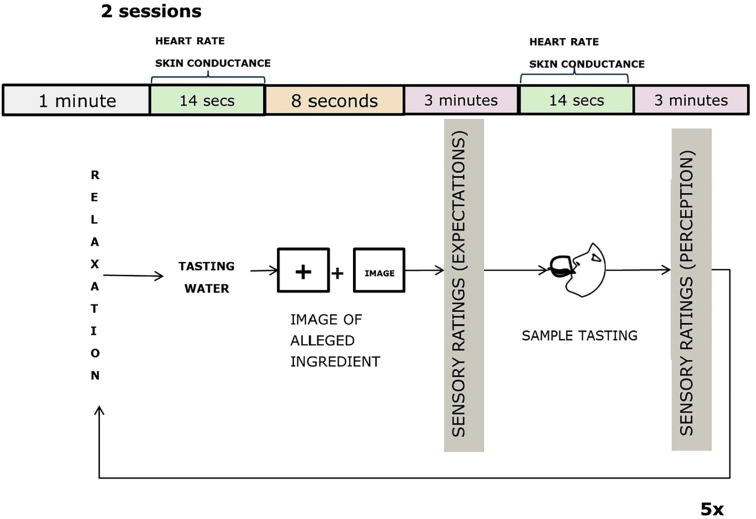当前位置:
X-MOL 学术
›
Food Qual. Prefer.
›
论文详情
Our official English website, www.x-mol.net, welcomes your
feedback! (Note: you will need to create a separate account there.)
Heart rate, skin conductance, and explicit responses to juice samples with varying levels of expectation (dis)confirmation
Food Quality and Preference ( IF 4.9 ) Pub Date : 2019-01-01 , DOI: 10.1016/j.foodqual.2018.08.011 Luz Verastegui-Tena , Hans van Trijp , Betina Piqueras-Fiszman
Food Quality and Preference ( IF 4.9 ) Pub Date : 2019-01-01 , DOI: 10.1016/j.foodqual.2018.08.011 Luz Verastegui-Tena , Hans van Trijp , Betina Piqueras-Fiszman

|
Abstract Disconfirmations between consumers’ expectations and a product’s actual properties can lead to different responses in consumers. Most researchers study these responses focusing on the final judgement of the product. However, looking at consumers’ physiological responses like those of the autonomic nervous system (ANS) could help complement what is known about consumer reactions and final response to disconfirmed expectations. This study evaluated how ANS responses change when tasting juice samples that were as expected, that differed slightly, or that differed greatly from manipulated expectations and whether these responses vary from those obtained when there is no manipulation of expectations. Eighty-six participants tasted fruit and vegetable juices in two separate sessions. They were divided in two conditions. In Condition A, expectations were manipulated by showing participants the image of an ingredient and then providing them with a juice whose flavour was as expected, differed slightly, or differed greatly from that of the image. In Condition B, each juice was first tasted without explicit information shown beforehand and the image of the ingredient was shown afterwards. The images were the same as in Condition A. Heart rate and skin conductance were measured. To confirm that participants perceived confirmations and large and small disconfirmations when tasting the juices, they rated the samples in different sensory properties before and after tasting them. Results from most of the sensory ratings, except sourness and taste intensity, showed that participants perceived the designed confirmation and disconfirmation of expectations accordingly. Regarding ANS responses, heart rate had a larger increase during the second session than during the first. Skin conductance responses increased in Condition A but decreased in Condition B. In conclusion, our design managed to create confirmations and varying levels of disconfirmations. ANS responses did not capture them but seemed to capture factors like attention and the orientation response.
中文翻译:

心率、皮肤电导和对果汁样品的显式反应,具有不同的期望(否定)确认水平
摘要 消费者的期望与产品的实际特性之间的不一致会导致消费者的不同反应。大多数研究人员研究这些反应的重点是对产品的最终判断。然而,观察消费者的生理反应,如自主神经系统 (ANS) 的生理反应,有助于补充已知的消费者反应和对未经证实的预期的最终反应。本研究评估了在品尝与预期一致、略有不同或差异很大的果汁样品时,ANS 反应如何变化,以及这些反应是否与未对预期进行操控时获得的反应不同。86 名参与者在两个不同的环节品尝了水果和蔬菜汁。他们分为两种情况。在条件 A 中,通过向参与者展示一种成分的图像,然后为他们提供一种味道与预期的一样、略有不同或与图像的味道有很大不同的果汁来操纵期望值。在条件 B 中,首先品尝每种果汁,事先没有显示明确的信息,然后显示成分的图像。图像与条件 A 中的相同。测量心率和皮肤电导。为了确认参与者在品尝果汁时感知到了肯定和大大小小的否定,他们在品尝前后对样品的不同感官特性进行了评级。大多数感官评级的结果,除了酸味和味觉强度,表明参与者相应地感知到预期的设计确认和否定。关于 ANS 反应,心率在第二次会话期间比第一次增加更多。皮肤电导反应在条件 A 中增加,但在条件 B 中下降。总而言之,我们的设计设法创建了确认和不同程度的不确认。ANS 反应没有捕捉到它们,但似乎捕捉到了注意力和定向反应等因素。
更新日期:2019-01-01
中文翻译:

心率、皮肤电导和对果汁样品的显式反应,具有不同的期望(否定)确认水平
摘要 消费者的期望与产品的实际特性之间的不一致会导致消费者的不同反应。大多数研究人员研究这些反应的重点是对产品的最终判断。然而,观察消费者的生理反应,如自主神经系统 (ANS) 的生理反应,有助于补充已知的消费者反应和对未经证实的预期的最终反应。本研究评估了在品尝与预期一致、略有不同或差异很大的果汁样品时,ANS 反应如何变化,以及这些反应是否与未对预期进行操控时获得的反应不同。86 名参与者在两个不同的环节品尝了水果和蔬菜汁。他们分为两种情况。在条件 A 中,通过向参与者展示一种成分的图像,然后为他们提供一种味道与预期的一样、略有不同或与图像的味道有很大不同的果汁来操纵期望值。在条件 B 中,首先品尝每种果汁,事先没有显示明确的信息,然后显示成分的图像。图像与条件 A 中的相同。测量心率和皮肤电导。为了确认参与者在品尝果汁时感知到了肯定和大大小小的否定,他们在品尝前后对样品的不同感官特性进行了评级。大多数感官评级的结果,除了酸味和味觉强度,表明参与者相应地感知到预期的设计确认和否定。关于 ANS 反应,心率在第二次会话期间比第一次增加更多。皮肤电导反应在条件 A 中增加,但在条件 B 中下降。总而言之,我们的设计设法创建了确认和不同程度的不确认。ANS 反应没有捕捉到它们,但似乎捕捉到了注意力和定向反应等因素。











































 京公网安备 11010802027423号
京公网安备 11010802027423号